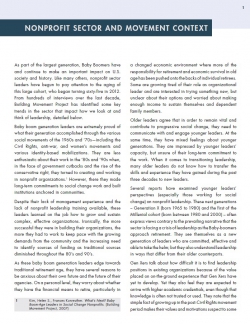Introduction: Nonprofit Sector and Movement Context
Tools in this Section:
Introduction:
As part of the largest generation, Baby Boomers have and continue to make an important impact on U.S. society and history. Like many others, nonprofit sector leaders have begun to pay attention to the aging of this large cohort, who began turning sixty-five in 2012. From hundreds of interviews over the last decade, Building Movement Project has identified some key trends in the sector that impact how we look at and think of leadership, detailed in the tools found in this section.
Older leaders agree that in order to remain vital and contribute to progressive social change, they need to communicate with and engage younger leaders. At the same time, they have mixed feelings about younger generations. They are impressed by younger leaders’ capacity, but unsure of their long-term commitment to the work. When it comes to transitioning leadership, many older leaders do not know how to transfer the skills and experience they have gained during the past three decades to new leaders.
Several reports have examined younger leaders’ perspectives (especially those working for social change) on nonprofit leadership. These next generations – Generation X (born 1965 to 1980) and the first of the Millenial cohort (born between 1980 and 2000) – often express views contrary to the prevailing narrative that the sector is facing a crisis of leadership as the Baby-boomers approach retirement. They see themselves as a new generation of leaders who are committed, effective and able to take the helm; but they also understand leadership in ways that differ from their older counterparts.
More work is needed to fully understand and address these dynamics, and to provide tools and resources for younger diverse activists stepping into leadership positions. The reports from Building Movement Project throughout this toolkit speak to some of these questions, and point to further research to be done.

